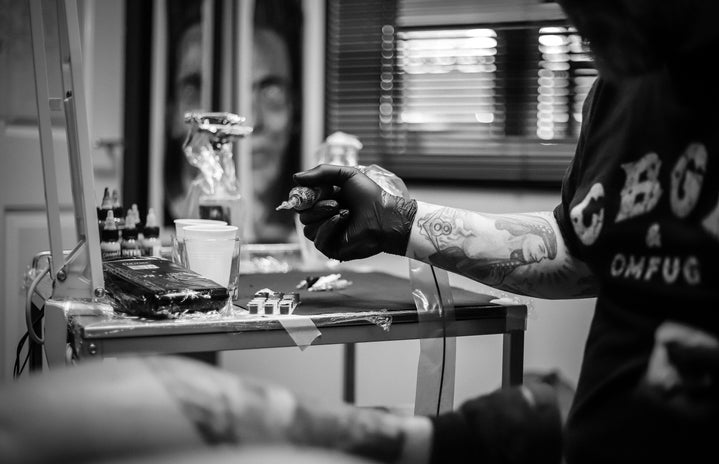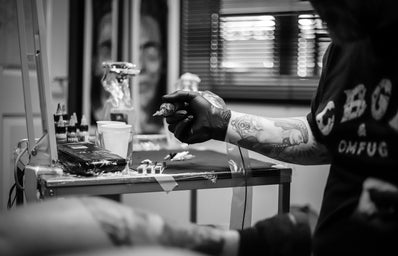Tattoos have slowly become somewhat more acceptable in society, with people starting to recognise them as legitimate art forms, instead of an indicator of criminality. Tattoos are a form of self-expression, and addictively expensive hobby, or simply something people get because they look cool. Though intimidating, tattoo artists are often considered some of the most affable and relaxed people you can come across. However, this sentiment is not shared by the plus-size community. For many fat people, the tattoo industry is ridden with severe underlying fatphobic tones.
Due to a lack of representation of plus-sized people with tattoos, the tattoo process can be quite a daunting experience for fat people. They don’t always have the resources to visualize what a certain piece or something similar, would look like on their own bodies. This leads to doubts about getting tattoos. On top of this, not many artists regularly tattoo fat people and sometimes don’t even display the work they’ve done on fat people, making the experience feel like uncharted territory. The inadequacy of resources and displays of tattoos for fat people creates many misconceptions regarding getting tattooed as a bigger person. With this article, I hope to shed some light on these misconceptions and make fellow bigger people feel more comfortable and confident in their tattooing journeys.
Probably the biggest misconception about being plus-sized and wanting to get a tattoo is that you “have to lose weight” before you can get a tattoo. Fat people often worry that their size is going to distort the image, causing the tattoo to look strange and weird. Fat people often set a lower goal weight before they get a tattoo, but often, never end up getting the tattoo. Simply put, you do not have to lose weight before getting a tattoo. People of all sizes can get tattoos. Your tattoo artist will account for your size when designing the tattoo, and remember, you first have a stencil placed before any tattooing is done. This will let you see, more or less, how the tattoo will look on you (without the colour) when it is permanent. This will help you decide whether or not to go through with it. Tattoo distortion really only comes into play with severe weight loss or gain. Fluctuating weight or merely being of bigger size, will not noticeably distort your tattoo. However, if you are worried about distortion, perhaps get the tattoo in areas like the back of your neck or your forearms, which won’t really change shape. So, if you’d like to get a tattoo, please do not feel like you have to wait to be a certain weight before you can get one. Tattoos are for everyone – all shapes and sizes.
Another misconception is that because of the stretch marks that come with being bigger, you can’t get tattooed in a lot of places. This is not entirely true. Friendly reminder that everyone, regardless of size, has stretch marks. It may not be to the extent of those that a plus-size person has, but everyone has them. So, if stretch marks were genuinely that much of a concern, even “acceptably” sized people would be worried about them. The important thing to consider when getting a tattoo is the severity of the stretch marks in the area you want to get tattooed. Stretch marks technically count as scars (and therefore scar tissue), which not every tattoo artist is comfortable tattooing over. If your stretch marks are light, your tattoo artist should have no problem tattooing over them. More experienced tattoo artists would also be willing to tattoo over deeper stretch marks – it’s just about finding the right tattoo artist. Additionally, there is a misconception that stretch marks will make your tattoo look ugly. However, with an experienced tattoo artist, this is false.
Ultimately, anyone who wants to get a tattoo should get a tattoo. Your size shouldn’t factor into your decision to decorate and present your body as you want. However, it is important to make sure that you avoid some (often very subtle) fatphobic tattoo industry tendencies.
Firstly, some tattoo artists may ask to reposition tattoos because they’re not happy to have their work on certain body parts of fat people since they think it will ruin their work. These body parts tend to be ones with stretch marks or areas they fear will stretch. However, if there is no legitimate reason to move the placement, don’t let the tattoo artist pressure you into changing it. Remember that the tattoo is for you and not for them. If you are comfortable having the tattoo in that area and are aware of the possible (very unlikely) results of it, then have the tattoo in that area!
Secondly, when researching tattoo artists, be sure to check their portfolios first. You’ll notice that not many tattoo artists display tattoos that they’ve done on plus-sized people. This is slightly fatphobic because it perpetuates the false representation of tattoos only being reserved for slimmer people. Additionally, the lack of evidence of having tattooed plus-sized people may also indicate a lack of experience in doing so. You may want to take note of this, especially in the event that you want to tattoo an area with stretch marks.
Tattooing is a unique form of self-expression and a way to add value to your body. Many fat people with tattoos claimed that it gives them more confidence in body parts that they weren’t previously comfortable with. Do not let your size dictate what you can and cannot do with your body. If you want to get a tattoo, do your own research on different artists, don’t hesitate to tell them your concerns about being tattooed as a plus-sized person and feel free to ask your possible artists for pictures of tattoos they’ve done on larger people. At the end of the day, you are in control of what you want, you dictate the process. If you want the tattoo, go and get it!


